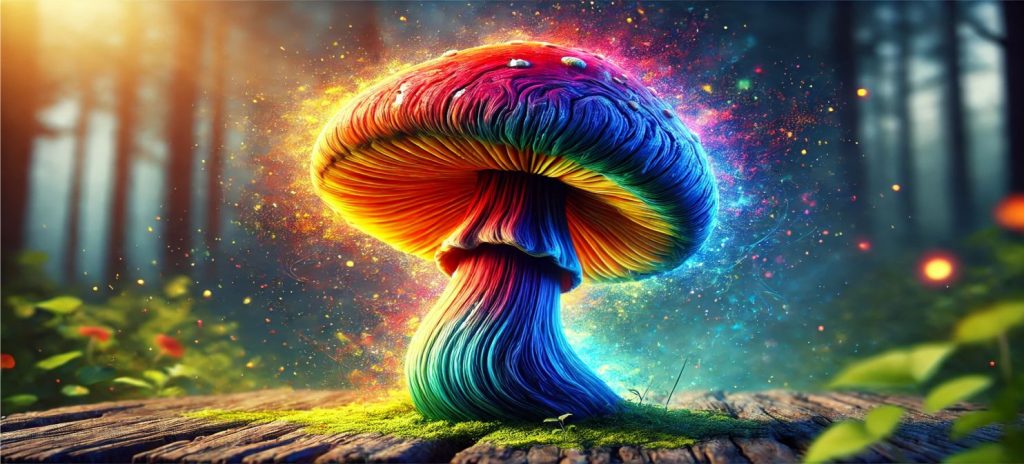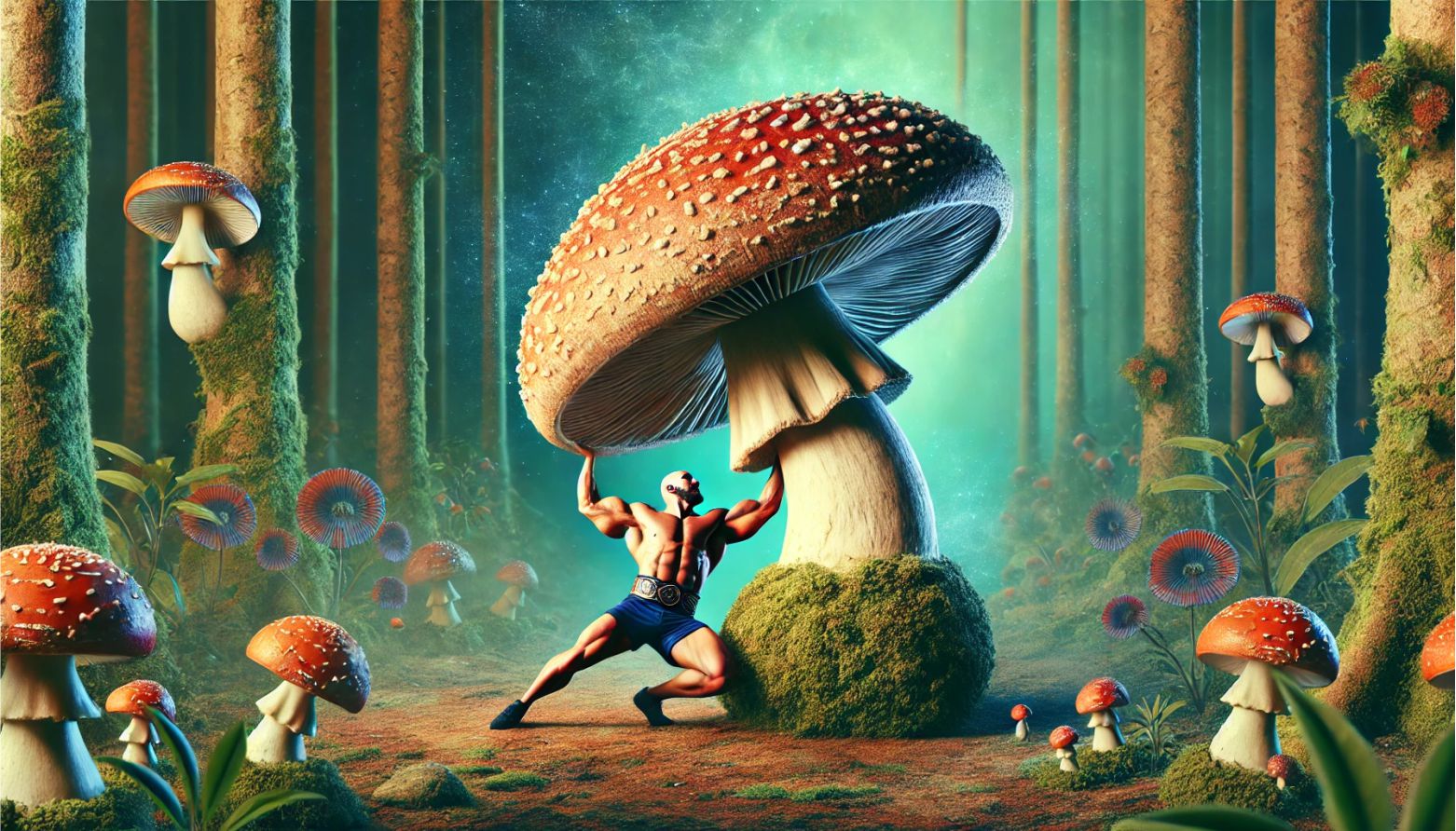Magic mushrooms, also known as psilocybin mushrooms or hallucinogenic mushrooms, have captured curiosity for centuries. The fungi contain psilocybin, a psychoactive compound that alters mood and perception. They are well known for their use in spiritual rituals and recently, they have started gaining more popularity for their potential therapeutic benefits.
Strongest Magic Mushrooms: Psychoactive Mushrooms
Among the many species of magic mushrooms, Psilocybe azurescens is often considered the strongest. The species is renowned for its high psilocybin and psilocin content, making it one of the most potent hallucinogenic mushrooms. Psilocybe azurescens occurs naturally along the coast of the Pacific Northwest, particularly near the Columbia River.
The Power of Psilocybe Azurescens
The mushrooms have a unique appearance, often described as having a dark purplish brown cap with bluish black zones. When fresh, they have a strongly bruising blue color, which is a sign of their potency. The caps are broadly convex, eventually flattening as they mature. The stipe base is usually covered with a tenacious mycelial mat, and they grow in separated clusters on decaying wood or sandy soils rich in nutrients.
Where Do They Grow?
Psilocybe azurescens prefers specific environments. They are commonly found in coastal dune grasses and sandy soils, often in areas where decaying wood is present. The mushrooms thrive in the cool, wet climates of the Pacific Northwest. The species’ preferred environment ranges from the coastal regions of Oregon to Washington. The sandy soils rich in organic matter provide an ideal habitat for the mushrooms.

Identifying Psilocybe Azurescens
Identifying Psilocybe azurescens is tricky if you’re not familiar with their characteristics. The cap has a light straw color when young and becomes darker as it matures. The edges are whitish, and the surface is smooth with a slightly incurved margin. The stipe, or stem, thickens toward the base and is covered with coarse white aerial tufts.
One distinctive feature of Psilocybe azurescens is their spore print, which is purplish black. That helps to identify them if you’re out foraging. Another characteristic is their extremely bitter odor, which is quite noticeable when they are fresh.
Effects of Psilocybin Mushrooms
The effects of psilocybin mushrooms varies depending on the species and dosage. Psilocybe azurescens, being one of the strongest, could produce intense and profound experiences. Users often report vivid visual and auditory hallucinations, a deep sense of connection to nature, and profound insights. The main active compounds, psilocybin and psilocin, interact with serotonin receptors in the brain, leading to altered perceptions and consciousness.
Higher doses of Psilocybe azurescens may lead to more intense experiences, which some describe as spiritual or mystical. Approach them with caution, especially if you’re new to psychedelics.
Legal Status and Safety
The legal status of psilocybin mushrooms varies by region. In some areas, they are decriminalized or legal for medical use, while in others, they remain illegal. Always check local laws before foraging or using psilocybin mushrooms.
Safety is paramount when using magic mushrooms. You should have a trip sitter, someone who is sober enough to help if things go wrong.
Exploring Other Potent Magic Mushrooms
While Psilocybe azurescens holds the title of one of the most potent psilocybin mushrooms, there are other species worth mentioning. Let’s dive into some other powerful hallucinogenic mushrooms that have captivated the minds and hearts of enthusiasts and researchers alike.
Psilocybe Cubensis: A Popular Choice
Psilocybe cubensis is perhaps the most well-known species of magic mushrooms. Found in tropical and subtropical regions around the world, the species is popular for its accessibility and relatively straightforward cultivation process. The caps of Psilocybe cubensis are broadly convex and may have a light straw color, which becomes more dingy brown as they age.
Psilocybe cubensis contains a big amount of psilocybin and psilocin, making them a favorite among users looking for a reliable and potent psychedelic experience. The mushrooms also exhibit a strongly bruising blue when handled, indicating their psilocybin content.
Psilocybe Semilanceata: The Liberty Cap
Another noteworthy species is Psilocybe semilanceata, commonly known as the Liberty Cap, which are pre prevalent in north temperate regions and are often found in grassy fields, especially those grazed by sheep or cattle. They have a distinctive conical or bell-shaped cap that ranges from light straw color to ochraceous brown.
The Liberty Cap is renowned for its high psilocybin content. Despite their small size, they pack a powerful punch and are considered one of the strongest magic mushrooms available. The combination of their potency and natural availability makes them a popular choice for foragers and psychonauts alike.
Psilocybe Cyanescens: The Wavy Cap
Psilocybe cyanescens, known as the Wavy Cap, is another potent species of psilocybin mushrooms. They are commonly found in wood chips and decaying wood, especially in urban environments and gardens. Their caps are wavy, and their color ranges from dark purplish brown to light straw color, depending on their age and moisture content.
Psilocybe cyanescens are known for their high alkaloid concentration, which includes psilocybin and psilocin. They also exhibit a strongly bruising blue when handled, similar to other potent species. They thrive in the cool, damp climates of the Pacific Northwest, often appearing in large populations during the fall and early winter.
The Role of Mycologists
Mycologists, like Paul Stamets, have played a crucial role in the study and popularization of psilocybin mushrooms. Paul Stamets, a renowned mycologist, has extensively researched the fungi, highlighting their potential benefits and advocating for their decriminalization. His work has shed light on the various species, their habitats, and their effects, making it easier for enthusiasts to explore the world of magic mushrooms safely and responsibly.
Cultivating Magic Mushrooms
For those interested in cultivating their own magic mushrooms, Psilocybe cubensis is often the species of choice due to its relatively easy cultivation process. The mushrooms are grown in a farinaceous habitat, such as grain or brown rice flour, and they thrive in a controlled environment with the right humidity and temperature.
Cultivating magic mushrooms allows for a consistent supply of fresh psilocybin mushrooms, which are dried and stored for later use. It’s important to follow proper cultivation techniques to ensure a safe and potent product. Resources like “Growing Gourmet and Medicinal Mushrooms” by Paul Stamets, published by Ten Speed Press, provide valuable guidance for aspiring cultivators.
Therapeutic Potential of Psilocybin Mushrooms
In recent years, there has been growing interest in the potential therapeutic benefits of psilocybin mushrooms. Researchers and mental health professionals are exploring how hallucinogenic mushrooms help with conditions such as depression, anxiety, and PTSD. Let’s take a closer look at the promising future of psilocybin therapy.
Psilocybin and Mental Health
Psilocybin, the main active compound in magic mushrooms, interacts with serotonin receptors in the brain. That interaction is believed to play a role in its therapeutic effects. Studies have shown that psilocybin may induce profound changes in consciousness, leading to improved mood and emotional well-being.
Depression and Anxiety
One of the most promising areas of research is the use of psilocybin mushrooms for treating depression and anxiety. Clinical trials have demonstrated that psilocybin-assisted therapy leadsd to reductions in symptoms. Participants often report feeling a renewed sense of purpose and connection to the world around them.
PTSD and Trauma
Psilocybin is also being studied for its potential to help individuals with PTSD. The ability of psilocybin to facilitate deep emotional processing and reduce fear responses makes it a promising tool for trauma therapy. Ongoing research aims to understand how psilocybin can be integrated into therapeutic practices to provide lasting relief for those suffering from PTSD.
The Role of Set and Setting
When using psilocybin mushrooms for therapeutic purposes, the concepts of set and setting are crucial. The “set” refers to the user’s mindset, while the “setting” refers to the physical and social environment in which the experience takes place. A positive, supportive setting could improve the therapeutic potential of psilocybin, leading to more meaningful and beneficial experiences.
Legal Status and Accessibility
The legal status of psilocybin mushrooms varies widely around the world. In some places, psilocybin has been decriminalized or even legalized for medical use. For example, cities like Santa Cruz and Ann Arbor have decriminalized possession, making it easier for individuals to access mushrooms without fear of legal repercussions.
Decriminalization Efforts
Efforts to decriminalize psilocybin mushrooms are gaining momentum in many regions. Advocates argue that psilocybin has significant therapeutic potential and should be accessible to those who can benefit from it. Decriminalization can also reduce the burden on local law enforcement agencies, allowing them to focus on more pressing issues.
Practical Tips for Safe Use
For those considering using psilocybin mushrooms, safety is paramount. Here are some practical tips to ensure a positive and safe experience:
- Start with a Low Dose: Especially if you are new to psilocybin, start with a low dose to gauge your sensitivity.
- Have a Trip Sitter: A sober person would provide support and assistance if needed.
- Choose a Safe Setting: Ensure you are in a comfortable and familiar environment.
- Stay Hydrated: Drink water throughout your experience.
- Respect the Mushrooms: Approach psilocybin with respect and intention.
Recognizing Psilocybin Mushrooms
Identifying psilocybin mushrooms in the wild often gets challenging. Look for key characteristics such as the dark purplish brown caps, bluish-black zones, and a strongly bruising blue color. The spore print of psilocybin mushrooms is often purplish black, which confirms their identity.
Common Varieties and Their Habitats
- Psilocybe Azurescens: Found in coastal dune grasses and sandy soils, particularly in the Pacific Northwest.
- Psilocybe Cubensis: Common in tropical and subtropical regions, often growing in fields with decaying wood.
- Psilocybe Semilanceata: Often found in grassy fields, particularly in north temperate regions.
Frequently Asked Questions About Psilocybin Mushrooms
Psilocybin mushrooms are fascinating and complex. Here, we’ll answer some of the most common questions people have about them.
How Do You Tell If a Mushroom Is Psilocybin?
Identifying psilocybin mushrooms in the wild requires careful observation of their characteristics. Here are some key features to look for:
- Cap Color and Shape: Psilocybin mushrooms often have a cap color that ranges from light straw color to dark purplish brown, with the cap shape being broadly convex to eventually flattening.
- Bruising: When handled, they typically show a strongly bruising blue color, especially on the stipe base.
- Spore Print: A purplish black spore print is a good indicator of psilocybin content.
- Odor: Some species, like Psilocybe azurescens, have an extremely bitter odor.
- Habitat: Psilocybin mushrooms are often found in specific environments like decaying wood, sandy soils, and grassy fields.
What Is the Proper Dosage for Psilocybin Mushrooms?
Dosage varies depending on the species and the desired effect. Here are the general guidelines:
- Microdose: 0.1 to 0.3 grams of dried mushrooms.
- Low Dose: 0.5 to 1.5 grams of dried mushrooms.
- Moderate Dose: 2 to 3.5 grams of dried mushrooms.
- High Dose: 4 grams and above of dried mushrooms.
It’s important to start with a lower dose to understand your body’s reaction and adjust accordingly. Always consider the potency of the specific species, as some, like Psilocybe azurescens, are much stronger than others.
How Long Do Psilocybin Mushroom Effects Last?
The effects of psilocybin mushrooms generally last between 4 to 6 hours. The timeline is broken down as follows:
- Onset: 20 to 40 minutes after ingestion.
- Peak: 2 to 3 hours after ingestion, with the most intense effects.
- Duration: The overall experience lasts 4 to 6 hours, with residual effects potentially lingering for a few more hours.
What Is a Trip Sitter and Why Is It Important?
A trip sitter is a sober person who stays with you while you are under the influence of psilocybin mushrooms. Their role is to provide support, ensure your safety, and help manage any potential anxiety or confusion that might arise. A trip sitter is especially important for beginners or when taking higher doses. They:
- Offer Reassurance: Help calm you if the experience becomes overwhelming.
- Maintain a Safe Environment: Ensure the setting remains safe and comfortable.
- Assist in Emergencies: Provide help if there are any physical or psychological issues.
Do Psilocybin Mushrooms Help with Depression or Anxiety?
There is growing evidence that psilocybin mushrooms treat depression and anxiety. Research has shown that psilocybin lead to reductions in symptoms of depression and anxiety, especially in cases where traditional treatments have failed. The therapeutic effects are thought to be due to:
- Neuroplasticity: Psilocybin may promote the growth of new neural connections.
- Emotional Processing: Facilitating deep emotional insights and reducing negative thought patterns.
- Altered Consciousness: Providing a new perspective on life and personal issues.
Clinical trials are ongoing, and psilocybin therapy is being explored as a promising treatment option for various mental health conditions.



